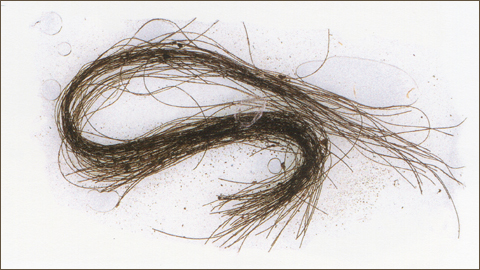First direct evidence of drug use in Europe's prehistoric populations found in Menorca
Researchers from the UAB and the UVa have managed to detect the consumption of different drugs in prehistoric populations inhabiting the island of Menorca some 3000 years ago, at the site of the Cova des Càrritx cave. This is the first direct evidence of drug use in Europe based on the chemical analysis of human hair. Until now, data on these types of practices were based on plants containing psychoactive components found at archaeological sites.

The study, published recently in the journal Nature-Scientific Reports, was conducted by Cristina Rihuete Herrada, Rafael Micó, Roberto Risch and Vicente Lull from the Research Group in Mediterranean Social Archaeoecology (ASOME) of the UAB Department of Prehistory; Elisa Guerra Doce, lecturer in the Department of Prehistory, Archaeology, Social Anthropology and Historiographic Science and Techniques of the University of Valladolid (UVa) and first author of the study, and Hermann M. Niemeyer, from the Department of Chemistry of the University of Chile.
The research focused on the scientific analysis of a sample of human hair from the Bronze Age discovered in the Cova des Càrritx cave (Ciutadella, Menorca, Balearic Islands). This site was used as a place of rituals and funerals during a large part of the Bronze Age. In 1995, in one its more hidden halls (number 5) a mysterious storage space was found with several wooden containers and horns filled with locks of hair. They belonged to some of the skeletons buried in one of the other halls (number 1), and had been dyed red and combed before being cut. "Thanks to the extraordinary conditions of conservation, the hair and all tools used to treat it have survived until today and we have been able to analyse it all scientifically", says Cristina Rihuete, who alongside other members of the ASOME-UAB group has conducted research at the Cova des Carritx cave and based her PhD thesis on this archaeological site.
Detection of ephedrine, atropine and scopolamine
The chemical analysis of a sample of these hairs, using ultra-high performance liquid chromatography coupled with high performance mass spectrometry, detected the alkaloids ephedrine, atropine and scopolamine. "Ephedrine is a natural stimulant, while atropine and scopolamine have hallucinogenic effects", explains Elisa Guerra Doce. Among the plant species found in Menorca containing these alkaloids are the joint pine (Ephedra fragilis), the mandrake (Mandragora autumnalis), the white henbane (Hyoscyamus albus) and the devil's trumpet (Datura stramonium).
Contextual data indicate that the drugs were consumed long before death. Moreover, it would seem that only a small group of people had access to these substances. The study poses the possibility that these people may have played a role similar to a shaman, i.e., individuals capable of acting as a liaison between the community and their supernatural imaginary, among other roles. In this case, their “special” character did not include political or economic privileges, given that the Menorcan society of that period was basically an egalitarian society.
The research reveals an unsuspected aspect of prehistoric life that will open new research lines in the future. It is also an example of the benefits of collaboration between different scientific disciplines, in this case between archaeology and chemistry.
Cova des Càrritx, a unique site
In 800 BCE, a rock fell and covered the entrance to the Cova des Càrritx, propitiating stable and constant environmental conditions. The cave remained sealed until 1995, when Menorcan speleologists Pedro Arnau and Josep Márquez managed to enter the cave after locating a small opening in the western slope of the Algendar ravine in Ciutadella, Menorca. The archaeological remains appeared along the 170 metres of the cave's length and in seven halls, all connected by narrow passageways and containing numerous stalactites and stalagmites.
Hall 1, which connects directly with the exterior, was first used as a cemetery around 1450 BCE. The anthropological analysis of the skeletal remains determined that more than 200 individuals had been buried there in 600 years, representing both sexes and of all ages, although no skeleltons were found of babies under 3 months old or of pregnant women.
Thanks to the preservation of an unusually large amount of objects, hidden in a very secluded part of the cave and more than 80 metres away from the burial grounds, researchers discovered a unique funerary ritual, apparently reserved to certain members of the community.
In an empty space of no more than 60 cm long and covered with a stone slab, researchers discovered several wooden cups, spatulas, spoons and a comb, and two small ceramic bowls, a bronze leaf and other elements made out of bronze, as well as several artefacts made out of bone and, most surprisingly, an abundant amount of locks of hair occupying the inside of small cilindrical wooden recipients made of boxwood, heath and olive wood, and in a bovid horn.
The forensic human hair examination revealed that all locks of hair measured up to 13 cm long and were dyed in red. This colour was possibly obtained from some of the plant substances identified in the botanical studies conducted at the burial grounds, particularly from wild madder (rubia peregrina), one of most suitable plants for obtaining red dyes.
Since no hair follicles were conserved, determining the biological profile (sex and age) of the skeletons belonging to the burial ritual was not possible. Shortly before the year 800 BCE, the last of the small recipients with locks of hair and objects related to this cult were hidden away, and not long after the entrance was sealed due to the fallen rock.
Interior chamber of the Cova des Càrritx, bowl and spoon, and a wooden comb found in the Menorcan site. Images: ASOME-UAB.
Article: Guerra-Doce, E., Rihuete-Herrada, C., Micó, R. et al. Direct evidence of the use of multiple drugs in Bronze Age Menorca (Western Mediterranean) from human hair analysis. Sci Rep 13, 4782 (2023). https://doi.org/10.1038/s41598-023-31064-2